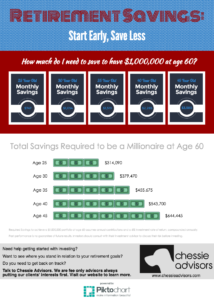Running and Retirement: Planning is Key to Success
Earlier this month, I was blessed to again be able to participate in the Indianapolis Mini Marathon, the kick-off event for the Indianapolis 500 festivities in the month of May and the largest half marathon in the country. It’s the 11th time in the last 12 years I’ve been able to run the race.
Somewhere between mile six and mile ten I begin thinking about how similar getting ready for the half marathon race is in comparison to planning for retirement, or lack thereof.
I’ll be honest, this year didn’t train as much as I should have. I was always coming up with excuses like “it’s too cold”, “there’s not enough time to train”, etc., etc., etc. It’s funny, but those same types of excuses prevent many people from sitting down and creating a plan for their own retirement.
The good thing for me is that I have experience running the course having done so eleven previous times. I knew the turns, the small hills. I knew where water and Gatorade stops were since I’d been through it many times before.
For most people entering retirement, they don’t have those same experiences to rely upon, without creating a plan. They simply haven’t retired before. This is their one and only shot. If things don’t work out, it’s very likely they may have to go back to work, possibly at an age not conducive to earning much income.
Every time I run a half marathon my goal is to finish in under two hours. Nothing crazy. I’m not a world class runner, but I’d say I’m slightly above average. In the 13 half marathon races I’ve completed (including 11 Indianapolis Mini Marathons) I’ve achieved that sub-two hour goal 10 times. This past weekend was not one of those. I attribute this year’s finish 100% to the lack of training. Sure, I completed the race, but just missed the time that I wanted to achieve by 18 seconds.
Training, Planning, and Preparation
Training, planning, and preparation help condition your body and factor into how will you run on race day. Without planning there is no Plan B (there’s only Plan A, “try to finish the race” and hope everything else falls into place). At times, Plan A becomes 100% pushing your body to the limit and trying to keep your head in the game mentally. If the weather doesn’t cooperate or your muscles are tight or you don’t get enough fluids, your goal time might be out of reach. If you haven’t trained properly (or at all) you likely don’t have Plan B fall back on and still meet your goal. You need to be all-out from start to finish and hope there are no surprises.
Retirement planning is a little different, there’s much more at stake. Instead of two hours, it’s more like 20, 30 or 40 years! Retiring without planning is almost like running a full 26.2 mile marathon without training or conditioning your body. You’ll probably do fine for the first 5 miles, but somewhere between miles 6 and 10, you’re asking yourself “why?”, and you’re not even half way through the race.
In an unplanned retirement, you’ll probably do fine for a few years, but at some point, unforeseen costs or inflation will hinder your level of comfort. You don’t always have the ability to forecast the future. Retiring two years early can have a significant impact on your financial quality of life. What if there is a shock to the markets and your portfolio is down 30 to 40% (like what happened to those that retired just before the Financial Crisis)? Can you still make it?
Sometimes you don’t ability to save more or retire later. But putting off savings now can have a pretty big impact 10, 15 or 20 years down the road.
The majority of Americans who contribute to their 401(k)s or employer plan don’t really worry too much about it. They contribute and don’t look at it, which can sometimes be a good thing. They just plug away at their jobs hoping to retire when that magical age arrives. For some it’s 62 and 1 month, the age at which you can begin taking reduced Social Security benefits. For others, it may be 65 or 70. Unfortunately, not planning for retirement can have a detrimental effect on the ability to survive financially in retirement.
What steps can you take to prepare?
No matter what age you are, 32 or 57, it’s never too early, or too late to prepare for your retirement. Here are three things you can do now:
Annual Check-up (at a minimum): An annual check-up with a doctor can help you spot diseases or conditions that may or not be visible and also keep you healthy in a preventative manner. The same is true for a financial advisor. An annual check-up can help you set-up a financial plan and then revisit it every year as your life and financial situation changes. The guidance you get from an annual check-up can help you avoid mistakes, make course corrections, or validate what you’ve already been doing.
Save for Retirement: The earlier you save for retirement, the less you need to save each year to meet your long-term goals. The chart below shows the power of compound interest. It illustrates the annual contribution needed starting at various ages in order to have $1,000,000 in your portfolio at age 60 while earning a 6% growth rate (compounded annually):
Minimize Lifestyle Creep: As you earn more and more income, the goods and services you used to consider “wants” often turn into “needs”. That’s not to say you shouldn’t ever spend more on nicer things, or you should live like a broke college kids forever, but to build wealth, you need keep “lifestyle creep” in check. When you get a raise, increase your savings first. If there’s money left over to “upgrade your lifestyle”, do it with the future in mind. Ask yourself, “is this cost sustainable?”
So what’s the best way to get started?
You can find a wealth of information online regarding various types of saving accounts and ways to reduce your expenses. If you’re looking for an advisor to help review your situation and provide an annual check-up or ongoing financial planning guidance, check out the XY Planning Network or NAPFA (the National Association of Personal Financial Advisors). Both organizations are made up of fee only Certified Financial Planners™. Fee only advisors are paid directly by their clients (no commissions or fees for recommending products.) Members of XYPN and NAPFA have also signed a fiduciary oath to always work in the best interests’ of their clients.
About Chessie Advisors
Erik O. Klumpp, CFP®, EA, founder of Chessie Advisors, LLC and Chessie Tax, LLC, believes that teachers, engineers, and young professionals should have access to objective, fee-only financial planning and investment management to help them create and realize their American Dream. For more information on the services offered through Chessie Advisors, check out our website, contact Erik, or schedule an introductory call



Comments are closed.